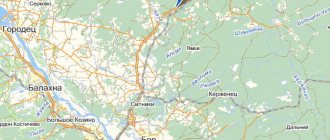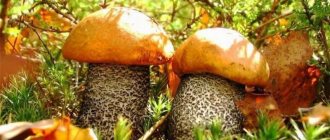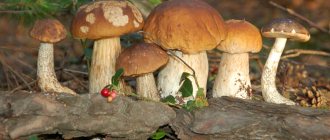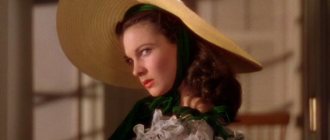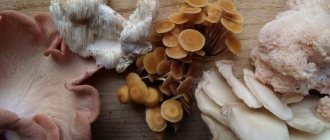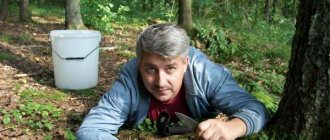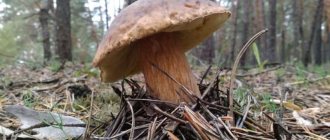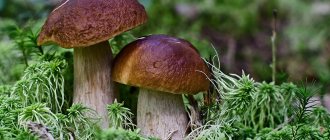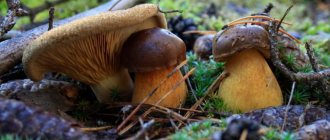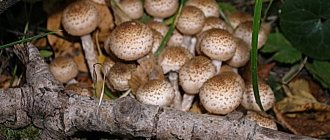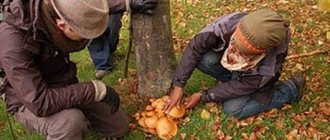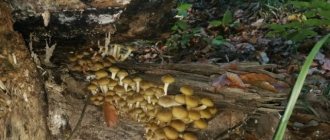If you remember, in one of the children's cartoons - a long time ago - there was a song with these words:
“...And in the Moscow region, bream are caught, There are mushrooms, berries, flowers. Don’t even look for a better place. You’ll just waste your time!”
Let's not argue: all this is true. Although the berries are almost gone, we’ll talk about fishing some other time. But mushrooms remain: the product is edible, filling and tasty - if you cook them correctly. In addition, you can already pick mushrooms in August. Hot weather, cut off by rain from the very comfortable days of late summer, literally pushes edible mushrooms out of the ground. Butter mushrooms, milk mushrooms, volushki, russula, chanterelles, honey mushrooms, and here and there porcini mushrooms - all this quiet joy awaits those who are not too lazy to leave home early on Saturday or Sunday. Moreover, it so happens that in the forests of the Moscow region, mushroom pickers along roads are rarely found today: lovers of “quiet hunting” are usually residents of regional dachas, “cleaning” forests within a radius of several kilometers from their hacienda. So, with some luck, you can bring home a good “catch”.
So, where will we go?
Kyiv highway
This direction is good because almost immediately beyond the end of the Vnukovo airport, forests begin on both sides of the road, which stretch all the way to Naro-Fominsk. For mushroom pickers, I would advise getting to the junction with the turn to Krekshino and Ankudinovo. There is a place to leave your car here: there is a gas station nearby, and there are free spaces near the junction. In addition, after turning onto Krekshino, you can leave your car on the side of the road near any of the surrounding villages, although choose places that are clearly visible in both directions. Otherwise, when you return, you may find the car with some damage to the body.
The second place is a forest area right behind the village of Selyatino (this is approximately the 50th kilometer of the Kyiv highway, right after the intersection with Malaya Betonka. There are no problems with parking here - you can park on the side of the road next to the overhead pedestrian crossing, or on the outskirts of the city. The forest is here stretches for about eight kilometers, smoothly passing into the vicinity of the tank training ground of the Taman division - the place is not well-trodden, there are a lot of edible mushrooms.
Point three – Kuznetsovskoe forestry. It's easy to get in. About six kilometers after Selyatino on the Kievskoe highway you will come across the first traffic light from Moscow. On it, under the arrow, to the left, towards Yakovlevsky. After a few kilometers there will be a turn to Kuznetsovo. There are absolutely no problems with parking here. Just keep in mind: the forest here is really dense; Experienced mushroom pickers advise beginners to take compasses or, better yet, a navigator. If you run into a river—it’s Ladyrka—it means you’ve “taken it” too far to the south. If you go with the current, you will come out on the road to Rudnevo (to the right) or Kuznetsovo (to the left), and against the current there is a direct path to the village of Kyiv and the Bekasovo platforms. By the way, there are also mushroom places around Bekasovo.
False saffron milk cap
Fortunately, this mushroom is not poisonous. After all, it is very easy to confuse the red pine saffron milk cap with its false double. This mushroom also has a bright red cap, although with green spots. And it produces bright juice, which gradually turns green. Even by smell, it is impossible to distinguish a false saffron milk cap from a real one.
These mushrooms can only be eaten in salted form. They cannot be eaten without pre-treatment because of the bitterness, which disappears after salting. But real pine pine mushrooms, red pine mushrooms and spruce mushrooms are even recommended to be consumed fresh. So, experts say, these mushrooms bring more benefits to the body.
Bohr highway
There is probably no point in trying to leave Moscow along the Borovskoye Highway - on your way you will encounter many traffic lights in Solntsevo (although, once you leave the city, you can drive several kilometers along a very good road). It’s probably better to continue along the same Kievskoye Highway to the repeatedly mentioned turn to Krekshino. And, at the first intersection, turn right onto a narrow two-lane road. Along it you will reach the village of Pobeda, the border of the town of Aprelevka. Leave your car here, cross the tracks of the Kyiv direction of the railway, and all the local mushrooms are yours.
Minskoye Highway: in the process of reconstruction
At Minka, active work is currently underway to put this highway near Moscow in order: in a year or two, traffic here will become traffic-lightless, at least from Lesnoy Gorodok. In the meantime, on weekends, there are significant traffic jams. However, the first “mushroom” place is not so far from Moscow, just north of the Zhavoronki platform. The turn to it will be a kilometer after Likino. True, according to people in the know, in recent years the harvests here have not been so great.
Therefore, it is best to drive a little further – until the turn to Golitsyno. And, having driven about two kilometers, stop on the side of the road near a forest near the Malye Vyazemy platform. It is possible to get lost here, but it is difficult: from the south the forest is limited by the M1 highway, from the north by the Belarusian direction railway.
You can drive even further north – to the vicinity of Zvenigorod or a little further north. They say there are good mushroom places in the vicinity of the Petelinskaya poultry farm, near the village of Chastsy. But you need to go here along the Mozhaisk highway - or through Odintsovo, or, if along Minka, then you need to turn towards Golitsino, and then, at Malye Vyazem - to the left.
Safety regulations
The forests in the Shchelkovo region are not as dense as the taiga, but even here it is possible to get lost. To prevent this from happening, it is better to follow these rules:
- Before starting a “silent hunt”, warn your loved ones about your location and route.
- Do not go into forested areas alone.
- Charge your phone (take an extra battery with you), and top up your balance if necessary.
- Prepare some provisions (bread, sandwiches), a knife, matches and a compass, as well as clean drinking water (1.5 liters per person).
- Wear bright clothing with reflective elements.
- Anyone who uses medications must have these medications with them (in quantities for 1-2 days).
- Start the journey in the morning (no later than 5-6 hours).
- Pay attention to noticeable places and other clues that help you navigate the area and remember the route.
New Riga and Volokolamsk Highway: for our own
Mushroom pickers who go in search of “pasture” in the vicinity of Novorizhskoye Highway usually travel by train to the Opalikha platform, and then on foot. But you can also get there by car. Along New Riga, until the turn to Novoye. You shouldn’t enter the village itself - it’s better to turn left, in the direction of Novoarkhangelskoye. Here, not far from the Praslikha River, you can leave your car and wander through the huge forest park. You can also get here along Volokolamka - after passing Krasnogorsk, almost at the exit from Anino you need to turn left onto Mira Street. You will drive up exactly to the platform behind which the forest begins.
And also - if along Volokolamka - you can turn right at the exit from Dedovsk - there are forests a few kilometers away. And mushrooms.
How to look for mushrooms
Mushrooms love moisture
Experienced people know that they need to harvest a few days after the rain, when the humidity and heat outside are high, especially if it is in July or August.
Irina Selyutina (Biologist):
For many, it will probably be a discovery that back in the days of the Soviet Union, Candidate of Economic Sciences A.I. Semenov developed an entire scientific system for searching for mushrooms, using for these purposes well-known methods for searching for commercial fish species in the seas and oceans. He suggested dividing the search into:
- preliminary: going into the forest, as preparation for a “silent hunt”, when a person looks at what could have changed, plans his route;
- detailed (actually picking mushrooms): it can be done in the following ways:
- "comb";
- “comb with projection”;
- “wave” or “zigzag” (best suited if the forest is transparent, that is, there are few trees);
- “stretched spring principle”: used to inspect the edge of the forest, inspect the spaces around each tree.
Mycelium grows strongly in the following trees:
- oil;
- oaks;
- pine trees;
- aspen;
- birches
Mushrooms can also be found under rowan trees, poplars and alders, but less frequently. Many honey mushrooms are found on old rotten stumps, and there are many other species in the forest on rotted leaves and with pine needles. Morels grow prolifically in unexpected nooks and crannies, like fire pits. But it is important to be able to distinguish them from morels, because the toxin gyromitrin is present in the apothecia of the stitches.
A bountiful harvest should be looked for on forest edges, along roads and paths through the forest, on lawns and clearings, and in other places. Where trees and bushes grow too densely or the grass is tall, it is better not to waste time; there is unlikely to be a bountiful harvest.
In the spring, you can walk through the forest, along the roads, looking for lines of morels. Many representatives of different types of mushrooms will appear from June to August. They love warmth, but when frost hits in the fall, their abundant growth stops. You can already find some mushrooms.
Winter mushrooms are found even in November, when it is quite cold. It is no longer possible to confuse them with other, often poisonous, species at this time. Not everyone knows, but until December, delicious violet rows and buttercollibia grow. Here's what you can collect within the area throughout the year.
Irina Selyutina (Biologist):
Professional mushroom pickers know what kind of mushrooms they came to the forest for. Therefore, they adhere to the following points in their search:
- in damp weather, mushrooms are looked for in drier places (highlands that warm up well even in damp weather);
- in dry weather, it is better to look in the shade of trees and where moisture remains;
- mushrooms like to settle where there are fewer tree trunks: in clearings, forest edges;
- the pine forest is inhabited by russula, moss mushrooms, boletus mushrooms, and boletus mushrooms;
- in the spruce forest you can also find saffron milk caps and chanterelles;
- floodplain forests: this is for lovers of morels and stitches;
- ideal conditions for the development of champignons have developed in the meadows and pastures.
Whatever route you choose, you need to move slowly and carefully look around. If you have already found one mushroom, then it is better to sit down next to it and look at the clearing from a different angle - mushrooms grow in “families” and such a change in the angle and field of view will help you find all the representatives of the colony.
Pyatnitskoye and Leningradka: the further into the forest...
In general, mushroom places here can be found right on the outskirts of the Kurkino and Mitino districts, near Khimki - surrounded by forests, although a little disfigured by human activity. But experts advise driving further – beyond the Black Mud, beyond the Sheremetyevskoye Highway. And park on the outskirts of the village of Elino. Boletus and honey mushrooms are found here. They say that porcini mushrooms are also found.
As an option, drive along Pyatnitskoye Highway to the Small Concrete Ring, and along it to the overpass over the Big Ring of the Moscow Circular Railway (just to find out later where you left the car) - there is a forest on the right, and a forest on the left.
Oak milkweed
They say that there are no false saffron milk caps. But some mushroom pickers claim the opposite. For example, oak milkweed, very similar to spruce, nevertheless does not enjoy the same popularity among lovers of “quiet hunting”. It is not poisonous, but has an unpleasant odor of rancid oil and hay. When cut, the mushroom secretes a white milky juice. The oak tree grows only in deciduous forests under oak trees.
Nosovikhinskoe and Gorkovskoe highways: be careful - peat bogs!
No, honestly: in these places (Pavlovo-Posad district) there was a lot of smoke just recently, just two or three weeks ago. Therefore, it is advisable to walk here carefully. Among the “generally recognized” mushroom places are the surroundings of the villages of Subbotino and Vlasovo. You can get to the first one by turning from Gorkovka to Pavlov Posad. Here, from Mira Street, turn onto 1st May Street, then, through the 1st and 2nd lanes of 1st May, exit onto Stepurinskaya Street, and follow it all the way to Subbotino.
You can get to Vlasovo along Nosovikhinskoye Highway, turning right towards Rakhmanovo. Continue along the highway to the U-shaped intersection. And there - either to the left, to Vlasovo, or to the right, to Semenovo - there are continuous forests all the way to Yegoryevskoye Highway.
The only thing is that it’s still far from Moscow...
Kashirka: under the wing of an airplane...
The area around Domodedovo Airport is also one of the recognized mushroom routes. But getting here is not so easy, if not by rail.
The best way is along the M4 Don, until the intersection with the Small Concrete Ring. Then turn left to Obraztsovo.
And after one and a half to two kilometers, a forest will begin on your left hand, which stretches all the way to the runways: if you hit a fence, then it’s time to take off.
And they also say that there are mushroom places in the Moscow region closer to Stupino (this is an hour from the Moscow Ring Road, no less).
PS The main thing is to remember: if you’re going to pick mushrooms, do it with a basket. If you collect mushrooms in bags, you will bring rotten dust home. Have a good hunting"!
Milkies. Distinctive features
This is the name of the genus to which saffron milk caps belong. And this is due to the fact that milky juice is released from them when cut. Its consistency is similar to milk, and its color is the same as its cap.
The color of the camelina can be very different depending on the species. There are mushrooms of the genus of laticifers that are grayish-yellow, orange, brown, red, pink, purple and even blue.
Some people take it upon themselves to say that there are even green lacticians. This statement is controversial. There are no green saffron milk caps that grow on Earth. That is, it cannot be said that green milkmen do not exist. Simply, when the released juice comes into contact with air, a chemical reaction occurs, as a result of which it changes its color. Therefore, green spots appear in places where saffron milk caps are damaged.
